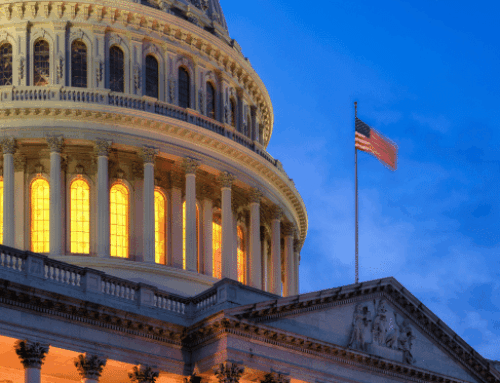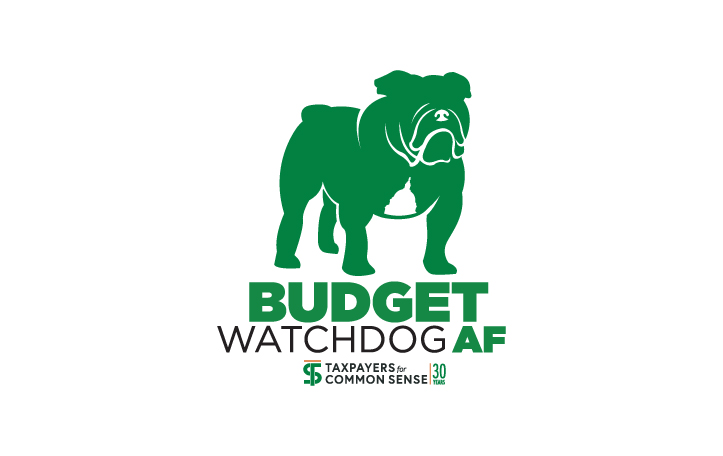In this episode of Budget Watchdog All Federal, host Steve Ellis and Director of Research Josh Sewell break down President Trump’s massive reconciliation package that passed the House by the razor-thin margin of 215-214. The “one big beautiful bill” extends the 2017 Tax Cuts and Jobs Act, exempts tips and overtime from taxes, raises the debt ceiling by $4 trillion, and makes significant cuts to safety net programs like Medicaid and SNAP. While the Congressional Budget Office estimates the bill adds $3.3 trillion to the deficit, the real cost could reach $5.2 trillion when accounting for budget gimmicks.
Transcript
Announcer:
Welcome to Budget Watchdog All Federal, the podcast dedicated to making sense of the budget spending and tax issues facing the nation. Cut through the partisan rhetoric and talking points for the facts about what’s being talked about, bandied about and pushed to Washington, brought to you by taxpayers for common sense. And now the host of Budget Watchdog AF TCS President Steve Ellis.
Steve Ellis:
Welcome to All American Taxpayers Seeking Common Sense. You’ve made it to the right place for 30 years. TCS that’s taxpayers for common sense, has served as an independent nonpartisan budget watchdog group based in Washington DC We believe in fiscal policy for America that is based on facts. We believe in transparency and accountability because no matter where you are on the political spectrum, no one wants to see their tax dollars wasted. It’s May 22nd, 2025, and in the early hours of this morning, the House of Representatives passed what President Trump calls his one big beautiful bill, a massive reconciliation package that could reshape federal spending and taxation for years. The vote was razor thin at two 15 to two 14 with one member voting present and two missing, highlighting the deep divisions even within the Republican party. Joining me today to break down the sweeping legislation is our director of research and policy, Josh Sewell. Josh, welcome back.
Josh Sewell:
Hey, thanks for having
Steve Ellis:
Me, Steve. It’s been quite a day. It has been quite the day. So let’s start with the basics, Josh. The reconciliation bill spans over a thousand pages and I know you’ve read them all and it took a marathon, 22 hour rules committee session to advance. So what exactly did the house pass this
Josh Sewell:
Morning? So I have at least looked at each page. I’m not sure I’ve read each one, but Steve. So this really is a massive piece of legislation and it touches many corners of federal policy. But at its core, the bill would extend the 2017 Tax Cuts and Jobs Act, which was passed under Trump’s first administration. Many of the provisions in that bill were set to expire or are set to expire at the end of this year. And so that alone carries a price tag of basically $4 trillion over the next decade. But really this big package goes far beyond that and includes all kinds of new tax treats that President Trump promised on the campaign trail, like exempting tips and overtime from taxes. It also raises the debt ceiling by 4 trillion, provides, I think it’s more than $300 billion in additional spending for defense, primarily for defense and border security. And then finally it makes some significant reforms which are cuts to safety net programs like Medicaid and snap, what used to be known as food stamps.
Steve Ellis:
Josh, the fiscal impact here is just staggering. What are the numbers that we’re looking at?
Josh Sewell:
Let’s put that out there. We don’t actually have a true final analysis from the Congressional Budget office. They have to produce their interactive effects, but we know the basic issue here. And so CBO is estimating that the bill would add about $3.3 trillion to the deficit, the cumulative deficits over the next 10 years. And frankly, that’s a conservative estimate because there’s a lot of gimmicks such as ending those aforementioned tax treats a little bit early. And so when you let those expire before the end of that 10 year window, you don’t have to count the costs. Now some of the folks at the Committee for Responsible Federal Budget and other groups have done some estimates and the one I saw from CFRB said that the actual price tag of this, if you extend those temporary provisions, which historically we do, it would be closer to about a 5.2 trillion increase in deficits.
Steve Ellis:
That’s just remarkable, especially considering this comes just a couple of weeks after we were discussing the administration’s. How do these two pieces fit together?
Josh Sewell:
They don’t. It’s the same cognitive dissonance that we talked about in our last episode, Steve, but it’s just on an even grander scale. And so while that skinny budget proposed cutting, like you said, it was $163 billion from various domestic programs, this bill would multiply those cuts 25 fold. I don’t know exactly the math. I haven’t had time to do it just through the tax cuts alone. And so frankly, it’s like trying to bail out a sinking ship with a teaspoon. Well simultaneously drilling new holes in the hole. It’s mind boggling.
Steve Ellis:
As you mentioned, the bill includes several of Trump’s campaign promises, including the no tax on tips and overtime. What’s your take on these policies?
Josh Sewell:
If I’m feeling generous, I’d say that these are classic examples of well-intentioned policies with potentially problematic consequences. The no tax on tips provision for instance, that sounds appealing, I’m sure especially to people who could use it, but it creates massive complexity in the tax code. Anytime you pick winners and losers in the tax code, you’re going to have increased complexity and some challenges. And I think in this one, when you read the bill, there’s an attempt to restrict this benefit to traditionally tipped occupations, but that’s up to the Secretary of the Treasury to define what that is. And we know that secretaries can be creative and also people out in the real world economy can be pretty clever when it comes to their taxes and defining where their income comes from. And so I mean the overtime exemption is also problematic. It is only temporary running from 2026 through 2028, which creates just by its nature uncertainty for both those workers and the employers who would be paying their employees. And so I just think it’s important to note that these benefits often also flow more to higher income service workers and some of the skilled workers than to those who really need the most help. And that’s kind of a challenge in any of these tax provisions as they tend to skew. Even the ones that may not be focused on the most affluent, they do skew towards those who make more money even in those lower tax brackets.
Steve Ellis:
So Josh, one of the most contentious issues during the negotiations was the state and local tax deduction known as salt. How did this get resolved?
Josh Sewell:
So first caveat, nothing’s resolved. This is only in the house bill. This stage in the game where we are today, it appears that from high tax states like New York and California demanded increases to the current $10,000 salt cap that was created in 2017 before the state and local tax deduction was unlimited. And so that cap, it’s the same for both individuals and married couples. Currently, this final deal actually raises the cap to $20,000 for individuals and then it quadruples it for households earning less than $500,000 and that is at the $500,000 mark or 250,000 for an individual. There’s a phase down. And so it’s not a true cap in that you’re not cut off, but it phases down. If you make a certain amount of money, you go back to the original $10,000 cap. This concession was key to securing enough Republican votes from the blue states, but it also significantly increased the bill’s cost and primarily benefits some very high income households.
Steve Ellis:
Yeah, the original offer on the table was an increase to 30 K and the Blue State Republicans, the SALT caucus countered with 60 2K that would then be doubled for couples. And so they came down quite a bit to settle down to 40 K is the top
Josh Sewell:
Paying 128,000 in state and local taxes, let alone being able to deduct it.
Steve Ellis:
Josh, the bill also makes significant changes to safety net programs, particularly Medicaid and snap the supplemental nutrition assistance program formerly known as food stamps. What are we looking at in those programs?
Josh Sewell:
So I think it’s fair to say that these changes represent some, the most consequential policy shifts in the bill. It would make a real difference in the way these programs run. And so starting in late 2026, childless adults without disabilities would need to work basically 80 hours per month to qualify for health insurance under Medicaid. And the bill also shortens enrollment periods from annual to, I believe it was every six months. So you have to enroll every six months and it adds new income and verification requirements. So basically additional steps to prove that you qualify for these benefits. And for snap, it’s very similar. There already are work requirements under SNAP for able-bodied adults without dependents, but this changes, it increases the age to which those would apply, and it also changes the definition of a dependent from anyone below the age of 16 to someone below the age of seven.
So individuals who have a child that’s school age would now be subject to the work requirements. The biggest thing inna, the most fundamental change is that the bill requires that the states now cover a portion of the benefits instead of the actual SNAP benefits themselves being 100% federally funded as since the program was created. When you look at the full ramifications, again, some of the stuff we’re still trying to figure out, but there have been various estimates and I saw one all of them suggest that these changes could result in potentially millions of people no longer qualifying for these programs.
Steve Ellis:
And there’s concerns that the states will pull back because of the additional contributions and also that it’s really how do you define able-bodied, how do you define without disabilities? What is a disability? Do they take into account mental health and things along those lines. And then even you can look at as my parents get older, you can also think about dependences being people who are of older generations, not just younger generations.
Josh Sewell:
And that’s exactly why I have sympathy or maybe it’s empathy for some of the criticisms that Democrats brought up specific to the AG portion of the bill, whatever we end up agreeing on the fundamental change to the SNAP programs, the shifting the cost share to the states and actually also having the states bear a greater burden for administrative costs of the program, not just the benefits. That wasn’t a subject of a single oversight hearing last year that was not in the House Farm Bill last year. And so the changes to work requirements, that’s been a discussion for the last three farm bills, the ones I’ve worked on, but shifting costs to the states which would end up being 128 billion according to CBO savings for the federal government, but a potential increase in the state government costs that we never had a single hearing on that. So I think the Democrats were right to say, if you want to do this, let’s at least have a debate because we didn’t get to have a debate on this.
Steve Ellis:
And since you mentioned that this is in the agriculture portion, it gives you a chance to get on a soapbox and tell me what part of the agricultural program doesn’t have a work requirement.
Josh Sewell:
Oh, it turns out you can get farm subsidies if you’re a farmer or claim to be a farmer without having to prove that you’ve done any actual work on the farm. They did essentially cram almost an entire farm bill into reconciliation package and significant cuts, projected cuts to the SNAP program, nearly 300 billion over 10 years. But on the farm side, we’re going to basically double the cost of the commodity titles. And so it’s more like a 60 billion increase, but with no changes to the underlying requirements that you have to have any sort of proof that you’re working on a farm and not just some sort of pass through entity.
Steve Ellis:
All right. I had to give you the opportunity to get that in since you were coming on the pod. So Josh, even within the Republican party, there was significant resistance to this bill and what does that tell us?
Josh Sewell:
So I could tell you a two 15 to two 14 vote margin tells the story. I mean, you had fiscal conservatives end up voting against Mr. Warren Davidson and he said he couldn’t support it because it’s a big deficit plan. You had moderates worried about cuts to programs that their constituents like or depend on such as again, the Medicaid and the SNAP programs. And even with President Trump personally lobbying Republicans coming to the Capitol and haranguing them in person and reportedly threatening primary challenges confident that isn’t just reported. I’m sure he did. That’s his nature. If anyone who opposed him, the leadership could barely scrape together enough votes. And it’s important to note that one member who voted present was Andy Harris of the Eastern Shore of Maryland. You might know he’s not just the chair of Agri Probe’s, subcommittee and appropriations, he’s also the chairman of the Freedom Caucus. His vote could be a signal from the caucus saying the Freedom Caucus saying this needs to be what we get across the finish line. And so I think it suggests it’s going to be a tough sled in the Republican party on the house side. A lot of concerns fiscally policy wise and politically down the line.
Steve Ellis:
Yeah, this is now heading to the Senate and I think that some of those moderates may have voted for it. Be hoping that whatever comes out of the Senate is going to be more generous in those areas where there were cuts. That’s a big gamble that they’re running there, but that’s certainly what I think that some of those members are thinking. And that’s also what some of the Freedom Caucus members are afraid of is that it’s going to come back and be more generous. So let’s talk about that, about what happens next. So as I said, the Bill’s heading to the Senate and Republicans have their own issues there.
Josh Sewell:
You already have some Republicans like Senator Susan Collins of Maine choose the appropriations committee chair who’s expressed serious objections to provisions. And she’s not the only one in the Ag Committee. Mr. Bozeman has said, yeah, we’re not going to do what you want in snap. It’s also important to note that
Steve Ellis:
Mr. Bozeman represents Arkansas, which isn’t. I can imagine that’s part of the concern as well. Is Arkansas going to pick up the tab?
Josh Sewell:
Yeah, exactly. And it’s also important to note that the Senate, it has different rules than the House, and it also has, each senator has their own priorities. They represent a state, not a district. People change their perspective when they move from the lower chamber to the Senate. And often, honestly, senators, they’re just I think more independent minded. They have six years before they have to run for reelection again instead of two. And so it just sort of changes the nature of how they operate oftentimes. And so I think, yeah, you’re going to have significant changes to the bill. Again, I think the Medicaid provisions go probably too far for a lot of senators. The SNAP most likely goes too far. And I don’t know it’s the Senate, maybe the tax breaks don’t go far enough. And even the spending, the one thing we see in the Senate is they tend to pare down the spending cuts and often increase the spending increases. And we’ll see if that holds true again.
Steve Ellis:
Yeah, and you’re talking about different rules. The fact that reconciliation instructions that were given to the committees in the house is different than the reconciliation instructions that were given to the committees in the Senate. And so they already have clearly differing views. And also the Senate is basically on board with in their budget resolution of adding about six and a half trillion dollars in debt to firm reconciliation. And that’s because they’re saying they’re going to do 2 trillion in additional tax cuts on top of the cost of extending TCJA, the tax cut and jobs act. And so it is going to be a different process. The other thing is too, is that while there are members that are Republicans that are in blue states, there aren’t really Republican senators that are in blue states. And so the salt cap issue dynamic changes quite a bit in the Senate as well.
And so that’s something that’ll be interesting. And then one other thing I should add on the salt cap is that most of the provisions, they just extended what they were doing in the tax cut and jobs act with the salt caps since they changed it, they actually made it effective for this tax year. So that essentially they’re making sure that otherwise you wouldn’t notice it until after the 2026 elections. And so they’re making sure that people know that they’re having that benefit before they go to the ballot box in November of 2026. So alright, that’s a lot of the political process, but let’s step back from that, Josh, and what does this bill mean for America’s fiscal future?
Josh Sewell:
So I don’t want to oversell it because everything’s the most important thing to ever happen in Washington, but this bill does, I think because of where we are fiscally and the choices that are being made, it does represent a fundamental choice about fiscal priorities at a time when our national debt is already at historic levels and interest payments alone are basically a trillion dollars right now where potentially if this bill goes forward, adding trillions more to that unsustainable burden. And I saw that the Penn Wharton budget model, which is credible and people use all the time, suggests that even with some economic growth, this bill would substantially worsen our long-term fiscal trajectory. They’re just one of many organizations pointing that fact out. And so we’re essentially borrowing money to give tax cuts today and the future generations are going to have to pay the bill with interest. It’s a choice we’re making.
Steve Ellis:
Alright. What about the distributional effects? Who wins and who loses under this legislation?
Josh Sewell:
Yeah, this is one you can’t really paint over. I mean, every analysis shows that there’s a clear pattern because of that. It’s so tax heavy in part, but also the way the tax choices are made. Higher income and households are generally benefiting significantly from the provisions, particularly what we’ve talked about a bunch the salt deduction as opposed to other households. But again, that Penn Wharton model estimates that the average household in the lowest income quintile would actually lose about $940 in 2026. That’s because of not just the changes of tax cuts, but the changes in benefits from these other programs. That would be a 13.6% reduction in average income for families earning less than $17,000, which are clearly low income households. Those safety net cuts are going to affect low income Americans who oftentimes rely on these programs. And so it’s an important issue. We have to get right and figure out all safety nets, need limits.
I think safety nets need to be tailored to need, but we’ve got to really ensure that a bill makes that balance between a narrow safety net and an appropriate tax policy because frankly in this bill, you’re looking at something that it’s going to provide tax benefits to higher earners, high income earners while making spending cuts primarily occur to programs for the poor. Maybe not as poor as some people think they should be as far as maybe you want lower income thresholds for accessing some of these benefits, but these are not high income folks who are going to be potentially affected by these cuts. The other thing about this is this truncated debate, like if you’re serious about reducing deficits, you have to either raise revenue or cut programs that people use. There’s no way around it or do both?
Steve Ellis:
Well, I think we’re in a point where we have to, if we want to try to close the deficit or at least slow the growth of the deficit, it’s going to have to come from revenue and it’s going to have to come from spending isn’t going to close that gap by any stretch of the imagination. And I want to be clear with our budget watchdog faithful, we’re not saying Medicaid and snap are perfect by any stretch of the imagination, but reconciliation is not the place to do reforms. And as Josh indicated, some of these were not even debated previously in Farm Bill, some of these changes. And so this is not the process to really make policy changes. So there’s been talk about this violating reconciliation rules because it exceeds deficit targets set in the budget resolution. What’s your take on that, Josh?
Josh Sewell:
So that’s a really good point, Steve. So the house’s own reconciliation instructions called for a maximum deficit increase of $2.8 trillion, which is an amazing conceit just at the beginning. But this bill actually clocks in at closer to 3.3 trillion. And so technically this should violate the budget act, but there’s been some creative accounting to work around this deciding what you actually count as being in effect and whether or not you count the debt service that comes about of this. And then you can always finagle some of the interactions between the programs. But I think the bigger issue is what you just mentioned, which is that reconciliation is a process that was created and designed for deficit reduction, not for adding trillions to the debt, not for making fundamental changes to either grow or shrink programs. And we’re seeing the reconciliation process being stretched far beyond its original intent and arguably far beyond a beneficial process for taxpayers who want a fiscally responsible government.
Steve Ellis:
So you’re saying, talking about fiscally responsible government, where does this leave taxpayers who want fiscal responsibility?
Josh Sewell:
Yeah, I think we’re at a crossroads. This bill certainly makes some significant changes to our tax code and it really sets us on a path to having a revenue level lower than what we need to meet our spending appetite. And at the same time, it’s making some major shifts in some of the social safety net programs and it’s setting up potential greater shifts in other ones later because this could be a precedent for how you tackle Medicare, which affects a lot more people than even Medicaid does. This is all happening with very little public debate and frankly, very little substantive debate in Congress because a lot of these fundamental shifts haven’t been debated on the committees of jurisdiction. And so I just think that taxpayers writ large need to understand that this bill isn’t just about tax policy and tax cuts or increasing border security and immigration enforcement. It really is the latest example that shows that the decisions in Washington are about fundamental questions of how much debt we are willing to pass on to future generations to pay for our current spending and tax appetites. And I think the decisions made over the summer in the Senate are going to have some significant implications.
Steve Ellis:
You got that right? So Josh, at the other end of Pennsylvania Avenue, we’re hearing from Secretary of Treasury, he dismissed Moody’s downgrading of our debt saying it’s a lagging indicator, but we’re seeing that bond markets are responding to true. Some of it was the tariff issues, but also about this debt level that we’re getting and that’s causing them to, it’s costing the government more to sell our debt. And so what are the implications of that, Josh?
Josh Sewell:
Well, I think this just shows that the lack of fiscal discipline in Washington is going to have real effects on Main Street and on Wall Street. And so if it becomes harder for us to sell our debt to finance our deficits, that trillion dollars a year that we are currently paying in debt service, we’re going to wish for those days potentially. And the more you pay for debt service, the less you get to pay for the things that you need in an economy, whether it’s infrastructure, investments, education, or frankly just the tax breaks do more tax breaks in the future. It’s going to be harder to do all that. It’s going to crowd out the ability for the government to respond to the legitimate needs in our country.
Steve Ellis:
We were already projected to run a $2 trillion budget deficit this year, and now you’re piling this, which I mean, again, it, it’s a 10 year number, but you’re piling hundreds of billions more onto that because of this loss revenue. You’re also making the markets jittery, and that means it’s going to increase the cost of servicing that debt. So it’s really kind of a perfect storm of fiscal malfeasance that’s going on by our government that’s putting us at risk. Well, budget watchdog. There you have it. The house passed. President Trump’s one big, beautiful bill, but the fight is far from over. The Senate now faces the challenge of crafting legislation that can pass both chambers while addressing the serious fiscal and policy concerns. This bill raises. This is the frequency. Mark it on your dial, subscribe and share and know this taxpayers for common sense has your back America. We read the bills, monitor the earmarks, and highlight those wasteful programs that poorly spent our money and ship long-term risk to taxpayers. We’ll be back with a new episode soon. I hope you’ll meet us right here to learn more.









